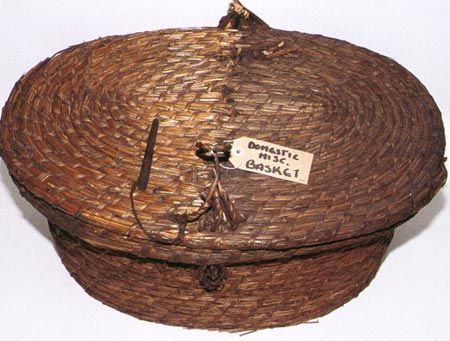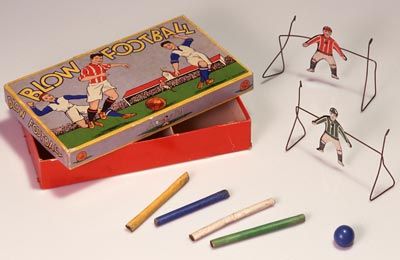From a complete farmhouse to a tiny matchstick: looking after the Social History collections at St Fagans
The Social History collections of Amgueddfa Cymru are housed at St Fagans. As it is an open-air museum, the objects range from historic re-erected buildings to small, fragile objects in an air-conditioned store. They vary in size from matches to four-poster beds, and can be as fragile as delicate Victorian shell ornaments or as robust as inscriptions carved on large stone blocks.

A basket from the domestic collections illustrating how simple surface cleaning can have a dramatic affect on an object's appearance.

Simple objects can be quite complex. This game is made out of three types of paper as well as metal, plastic, pigments and paints.
Single objects can often be made of more than one material. This means that parts of the objects need different preservation techniques. Conservators have to assess new objects to stablise them, and items in the stores have to be regularly checked.
Conserving for the future
All objects in the Museum's collections need to be structurally sound and chemically stable if they are to survive. The first stage of treating any object is to examine it closely to see if it is complete. If it is dirty, we have to assess whether the dirt is important to the history of the object. When considering damage, it is important to understand whether the damage happened during manufacture or through use.
Conserve the old original or display a fully restored object?
These days, visitors do not expect every object to be "perfect". This means that we can focus on preserving what remains rather than restoring what has been lost. It also means that important information about manufacture and use is not hidden or destroyed.
Having recorded an object's condition, we then apply relevant treatments. In some cases, further decay can be prevented or at least slowed by repackaging the object in acid-free materials and storing or displaying it at the correct temperature and relative humidity. When objects sensitive to fading (for example objects with dyes and pigments) are put on display, they can be displayed in reduced light.
Social History objects can be made from almost anything, and nearly always use a variety of materials. Even if an artefact is entirely made out of wood, several different woods might have been used.
Before conserving the object, we have to carry out tests to make sure that none of the solvents we use dissolve any part of the object. Whatever the treatment used, its application is kept to a minimum. Repairs should never obscure any details on the original object. We use a rule that a specimen should appear complete from a distance of 6 ft 6 ins., but the repairs can be seen on close examination.
All aspects of this work are recorded. This means that the full history of the object is always available for reference. It also increases the information we have about the ageing of modern materials, as all treatment dates are recorded.
The final stage of treating any object is to make sure that it enters or returns to a suitable environment, and that anything likely to cause decay or damage is minimised or removed. Monitoring the environment and regularly checking for pests are essential.
As museum collections expand, so does the conservation work required. This has increased the emphasis of preventative conservation, for example, where a large number of objects can benefit from a small change in the environment or working practice. By revisiting the way objects are displayed and stored, we hope to move towards sustainable conservation.